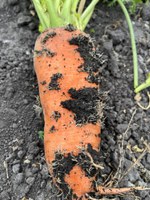Dakota Gardener: Credit to plant roots
(Click an image below to view a high-resolution image that can be downloaded)
By Carrie Knutson, horticulture agent
NDSU Extension – Grand Forks County
After a productive year, my garden is finally at rest. When I clean out my garden, I usually cut my plants off at the soil surface instead of pulling them out of the soil. However, when I dug my carrots I did take a moment to admire the roots.
This got me thinking that we need to give more recognition to plant roots. Most often roots are the forgotten part of the garden. We are usually concerned with leaves, stems and fruits. Roots are taken for granted unless there is root rot, wilt or other root-related disease.
Plant roots are fascinating. They are responsible for anchoring the plant in the ground and collecting water and nutrients for plant processes. They can store and transport nutrients. Think carrots, beets and other biennial plants.
Roots also produce hormones that stimulate plant growth and development. Plant roots are not selfish. They help the environment by preventing soil erosion.
The two types of root systems are fibrous and taproot. Taproot systems have one root that is more dominate than the other roots. An example is a dandelion. In fibrous root systems, no root is more dominate than the others, and roots are all about the same size. Turfgrass is a good example of a fibrous root system.
Feeder roots are the roots that do the work when it comes to water and mineral uptake. A root’s system size depends on soil moisture, temperature and type as well as plant characteristics.
Young roots and root hairs absorb the majority of water and nutrients. Root hairs are extensions of the outermost cells on roots. They provide a massive surface area for absorption. Root hairs are short lived and new ones are replaced as the roots grow.
The area around the root and extending a bit into the soil is called the rhizosphere. It is an area of action around the root. Roots produce a substance, think plant slime, that helps them move through the soil and maintain better contact with soil particles. This helps with nutrient absorption.
The rhizosphere also supports beneficial microbes for a healthy plant and soil environment. An example of a healthy microbe that thrives in the rhizosphere are mycorrhizae fungi.
Mycorrhizae fungi form a beneficial association with plant roots. The network of mycorrhizae fungi extends beyond the range of the plant roots. This network extension helps the plant get water and nutrients from a much larger area.
Give your plant roots the credit they deserve. Encourage root growth in your garden by preserving soil structure through reduced tillage, and add compost to feed plants and beneficial soil microbes.
Happy gardening!
NDSU Agriculture Communication – Nov. 1, 2022
Source: Carrie Knutson, 701-780-8229, carrie.knutson@ndsu.edu
Editor: Kelli Anderson, 701-231-6136, kelli.c.anderson@ndsu.edu




